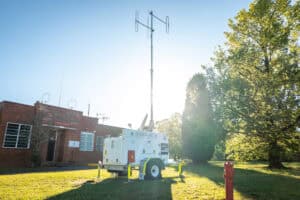Transit authorities driving a better experience for their passengers
Staying connected across a transit journey is important, not only to ensuring quality traveller experience but also traveller safety. Reliable connectivity enables critical safety features like high resolution in-train CCTV, train status data offload and alarm reporting. It also improves customer access to train-borne infotainment and passenger Wi-Fi services.
Our connected world means that the expectation to remain online when travelling will continue to grow. Passengers want to make the most of their journey by staying connected at all times with their favourite content, colleagues, family and friends. While a focus on improving the experience for their passengers is important, transit authorities must also maintain the operation of complex infrastructure without compromising quality and safety.
BAI Communications (BAI) has the experience to understand the relevant challenges and adopt a customer first approach to delivering solutions. Let’s look at a transit connectivity use case and how BAI can provide train-to-ground solutions which address growing connectivity needs.
The scenario: Service and security upgrade
Continuous improvement to service and security systems are a necessity for any transit authority. In this use case, the transit authority is looking to overhaul train-to-ground networks across the entire system, to provide higher data throughput between trains and the core network.
The transit authority wants to improve the train’s closed-circuit TV (CCTV) capabilities, to support more cameras at higher resolutions as well as improve passenger safety and operational efficiency. In addition, they want to improve bandwidth and stability for other systems, such as on-train infotainment, train-status data offload, alarm reporting and possibly passenger Wi-Fi services.
In this example, BAI assumes the responsibility to design, install and test the upgraded train-to-ground network. They are also expected to maintain the initial operation, before handing over the maintenance to the transit authority. As a neutral host provider, BAI takes a vendor agnostic approach to address specific customer challenges, sourcing and implementing the best solution for each unique situation.
Example deployment for train-to-ground
a) Upgrade antennas, poles and access points
Upgrades and ongoing improvements are important for transit authorities to maintain and support alongside existing transit services. In this use case, key design specification and therefore potential challenges include:
- Throughput
- Packet loss
- Latency
- Network recovery time on failure
- Wireless handoff time
BAI’s methodology is to design and then prototype a system that addresses or exceeds customers’ requirements. In our approach to address the specific requirements of this use case we would deliver a solution with the following capabilities included:
- Frequency and bandwidth: A new train-to-ground network using the 5 GHz spectrum band, with a single 80 MHz bandwidth channel.
- Trackside access points and antennas: Access points positioned strategically along the track to accommodate obstacles (such as bridges) that block line of sight. Trackside space constraints necessitated a pragmatic solution for pole-mounted antennas.
- On-train antenna placement: Addressing unique customer requirements for deployment for antennas (the ideal solution), in a particular case having them to be mounted under the hood and above the driver window. This in turn required unidirectional antennas rather than omnidirectional / bidirectional units.
- Fibre installation: A single 24-core fibre connection along the line to link the trackside access points in a hybrid star / daisy chain configuration.
Example train-to-ground use case
Highlights:
- Private 5GHz technology
- Trackside access points and antennas
- Supporting connectivity and CCTV cameras on the train
b) Train antennas and trackside access points
The ideal location for a train-mounted antenna is on top of the car’s roof (as seen in the graphic above). However, transit authorities may have specific requirements which prevent normal installation practices.
For the purpose of this use case, due to space constraints, the trackside access point poles now have to be installed with a minimal gap between two back-to-back directional antennas (the ideal gap is 200 mm). Upon initial deployment using unidirectional antennas on the trains, performance is reported as less than ideal. With trains experiencing a Radio Frequency (RF) shadow as they pass the trackside antenna poles and connections are handed over to the next access point.
To overcome the RF performance issues caused by the antenna placement in this instance, BAI would source and leverage a third-party patented technology from our list of ecosystem partners to ensure the train-borne access point handed the active link over to the second-best trackside access point as the leading cab approached the trackside pole. The third-party is expected to also provide a robust suite of commissioning tools for system parameter tuning. The BAI team then reviews the RF coverage and throughput performance and carefully tunes the system parameters to achieve optimal performance.
c) Antenna alignment
Antenna alignment and access point handover routine optimisation is a key function that BAI undertakes with any project. BAI’s engineering and deployment teams have worked through some of the most challenging RF environments possible. As mentioned above, project has critical space limitations making antenna options and installation locations a key challenge.
Given that BAI has extensive experience working in tunnels, on trains and in stations, the deployment team in this case is able to rely on the lessons learned from other large-scale deployments like those undertaken in Hong Kong, New York and Toronto. This comprehensive knowledge helps to reduce optimisation time and prepare for unforeseen obstacles. In ideal situations, the antenna placement and optimisation are simple, but BAI recognises that subway tunnels and low tolerance spacing on trains requires more effort and understanding.
Key takeaway: Optimisation
In this use case the team learned that complex projects should include additional time for optimisation, including stages for testing, tweaking equipment, refining antenna alignment, and optimising access point handover parameters.
Just as we have with real-world transit customers, BAI would continue to identify further opportunities and functions for upgrading the network. These could include deploying communications-based train control systems and additional third-party services such as mobile network operator Wi-Fi offloading and installing small backhaul 5G cells on the train.
By combining tried-and-true technologies with a collaborative, team-based approach to design, deployment, testing and operations, BAI has demonstrated the capability to deliver a robust, high-quality connectivity to passengers across any transit network.
*BAI Communications is now Boldyn Networks in the Northern Hemisphere.







